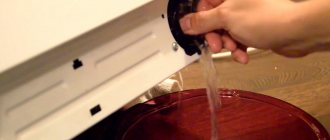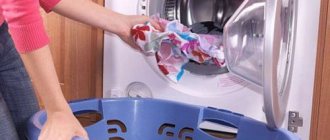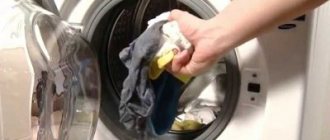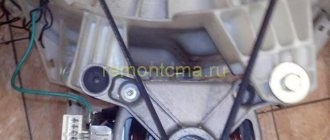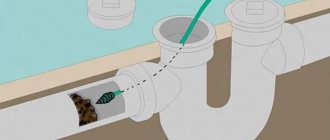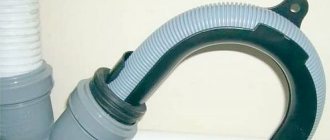It happens that after washing is completed, the laundry remains wet. If things feel wet to the touch, and not just slightly damp, or water flows from them like a river, the washing machine does not spin out the laundry. But we’ll figure it out why.
The good news is that you can often fix the breakdown yourself. The main thing is to diagnose the problem.
The manual is universal and is suitable for all vertical and horizontal models of the brands Ariston, Bosch, Candy, Gorenje, Indesit, Samsung, Siemens, Zanussi, Ariston, Bosch, Aeg, Beko, Electrolux, Haier and others.
Wrong choice of washing program
If the machine stops spinning clothes, pay attention to what washing mode is set. There are a number of programs where this function is not provided at all. For example, spinning is not carried out when washing silk or wool. To fix the problem, just change the mode to the desired one.
Pressing the “Cancel Spin” button
Some models of automatic washing machines have a special button that allows you to completely disable the spin function. It’s not difficult to find: there is a crossed out spiral drawn on it. You or someone in your household may have pressed it accidentally. To solve the problem, simply press this button and the spin function will be restored.
Incorrect spin speed setting
In addition to automatic programs, washing machines have special controls that allow you to control the settings. One of these is the lever or button for setting the number of revolutions. Look, maybe your regulator is turned to o. If this is indeed the case, then to fix the problem, set it to the required number of revolutions.
Engine repair
The washing machine does not spin clothes due to a breakdown of the power unit? If the machine is equipped with a conventional belt motor rather than an inverter motor, the brushes will gradually wear out, causing a problem. If the motor is not running properly, the drum cannot reach the speed required for the final washing phase.
You can solve the problem yourself if you have mechanical knowledge: you need to remove the back wall of the case, then the strap from the electric motor and disconnect the wires, and then unscrew the electric motor itself from the drum. During diagnostics, faulty engine parts can be identified and replaced with new ones.
How to determine a power unit failure:
- if the engine sparks during the test, then the brushes need to be replaced;
- in case of strong noise and overheating of the equipment, the cause may be a violation of the integrity of the winding;
- peeling of the lamellas and the appearance of burrs on them entails the occurrence of sparks.
The lamellas should be checked during disassembly at the same time as the graphite brushes.
Figure 7. Engine.
Damages need to be eliminated as follows:
- Turn off the machine - disconnect drains, water pipes and electronic networks.
- Disassemble the product body: remove the panel and straps.
- Unscrew the bolts securing the engine.
- Disconnect terminals and wires connected to other elements.
- If the tank prevents access to the engine, you need to lift it.
- Different models have an individual device, so you need to remove the walls on the sides of the unit to properly remove the motor.
After this, you need to lift the broken elements or tighten their fastenings for normal operation.
Error in the distribution of laundry in the drum
Any automatic washing machine distributes the laundry around the drum in a certain way before spinning. This is a necessary condition that allows not only to perform a high-quality spin, but also to avoid shaking during the washing process.
If the laundry cannot be distributed, for example, it has formed a lump or the item is light and alone, the program may not allow spinning. At the same time, an error code appears on the display of some models. You can solve the problem manually. To do this, drain the water, open the hatch and untangle the laundry, distributing it evenly. After this, set the spin program.
To start
If the problem has appeared for the first time, it is too early to sound the alarm. Maybe the reason is not a breakdown. First of all, go through the following points and check if everything is in order.
“No spin” program selected
Check the icons on the dashboard. You may have accidentally selected a washing program that does not involve spinning.
Balancing the washing machine drum
An imbalance may have appeared in the washing machine - the laundry has overlapped each other, forming one large lump of things. To fix this, you need to center the drum. Open the hatch and distribute the laundry evenly throughout the entire volume of the centrifuge. From now on, when loading things, try to avoid imbalance and we recommend reading the operating instructions - modern washing machines sometimes have an automatic adjustment function.
When spinning, the machine may rattle and jump on the floor from side to side:
- The drum is unbalanced - the crosspiece fastenings may have become loose, the shaft is bent, or the ribs or body are damaged. The part is made of stainless steel, so it must be handled carefully.
- The transport bolts have not been removed.
- The shock absorbers have failed.
Load Exceeded
Each machine’s passport indicates how many kilograms it is designed for, usually from 3 to 8 kg. If the permissible weight is significantly exceeded, the centrifuge will become loose, and strings and holes will appear on your favorite things. This is especially true for delicate items, such as a down jacket. The way out of this situation is to remove the excess laundry. It’s better to wash it twice than to spend money on repairs later.
Blockage
A blockage has formed in the filter or siphon, which prevents water from flowing into the sewer. The control unit does not give a command to pump out liquid after washing, and does not start spinning.
- First, you should inspect the drain filter.
- If it is in order, check the siphon and connection to the drain. You can clean these parts yourself.
- Another thing is if the pump pipe (drain pump) is clogged. You will have to disassemble part of the washing machine or entrust it to a specialist.
The interference filter is broken
This filter protects the automatic washing machine from power surges. This is a board with capacitors that is installed inside the “washing machine” body. The power cord from the outlet is connected to it. Sometimes, after severe power changes, the wash “freezes” and the program does not start spinning.
You can diagnose the breakdown and replace the element yourself. But when it comes to electrical work, it's best to leave the job to a professional.
Exceeding the range of motion inside the tank
Modern models of washing machines are programmed to detect the amplitude of vibrations of the laundry inside the tank during spinning. If the level of fluctuations exceeds the permissible norm, the device simply stops spinning the laundry. There may be several reasons for exceeding the amplitude of oscillations.
Incorrect installation of the washing machine
This often happens when the machine is installed on an uneven floor or an obstacle gets under the leg. To solve the problem, you need to adjust the legs of the device, preferably using a level. Use special pads or rubber mats to keep the machine stable.
Failure of shock absorbers
The task of shock absorbers in a washing machine is to dampen vibrations in the tank. The reason for premature wear of shock absorbers can be washing large masses of laundry, which during the spin cycle are constantly lumped together, creating an imbalance. As a result, the machine begins to jump, and the spin quality decreases significantly. If the shock absorbers do not work at all, then in this case the spin mode may not turn on. Replacing the shock absorbers will help solve the problem. In this case, it is best to seek professional help.
Main causes and symptoms of malfunction
To understand that your washing machine has stopped performing the spin function, you should know the characteristic signs of this negative manifestation:
- The program is completely finished, but there is still liquid in the drum. The drain function does not work;
- the things in the drum are quite wet;
- the water drains too noisily;
- draining occurs as usual, but things are not wrung out;
- the spin function works every other time, the washing machine refuses to respond to the entered parameters;
- the machine hums as if it is spinning clothes, but in reality this does not happen;
- The drainage is quite slow.
These are the main signs to look out for. What are the reasons why the washing machine does not spin clothes? The washing process is incorrectly programmed
Often, it is precisely such errors that become the reason for the machine’s refusal to wring out washed items. For example, we defined delicate washing. A number of models do not perform spinning in certain programs, even when a certain number of revolutions is assigned as an addition. You just need to check which mode you have defined. To know exactly when the washing machine spins things out and when it doesn’t, it is recommended to study the operating instructions, which describe such things in detail. The problem can be solved simply - the spin function is turned on separately, then programs in which it is present are selected
The washing process is programmed incorrectly. Often, it is precisely such errors that become the reason for the machine’s refusal to wring out washed items. For example, we defined delicate washing. A number of models do not perform spinning in certain programs, even when a certain number of revolutions is assigned as an addition. You just need to check which mode you have defined. To know exactly when the washing machine spins things out and when it doesn’t, it is recommended to study the operating instructions, which describe such things in detail. The problem can be solved simply - the spin function is turned on separately, and then programs in which it is present are selected.
Unevenness when loading things. When one heavy item or several lighter ones are placed in the drum, the machine is not able to properly distribute them throughout the drum. This causes an imbalance, a particularly sensitive sensor begins to detect significant vibration, and the machine reduces the number of revolutions to save the drum from unpleasant shaking. This happens when a load of laundry gets bunched up. Add several small items to one large item to balance the load. The second option is to distribute the laundry more carefully along the drum walls.
- Water does not pour out. When it remains in the drum, the washing machine does not spin. The sensor responsible for monitoring the water level sends error information and the drum stops rotating. Perhaps the problem lies in the pump responsible for draining, or the filter is clogged. It happens that the water drains, but the washing machine still does not work in the spin mode. In this case, it is recommended to check the sensor responsible for the liquid level.
- The tachometer has failed. With its help, the number of revolutions made by the drum is controlled. When an element breaks, the washing machine is simply unable to activate the spin process. This type of failure can be found at any manufacturer. It often happens due to the long service life of the unit. It’s rare, but it does happen when the reason that the machine stops squeezing things out is due to loose fasteners.
- Malfunction of the module responsible for all control. It can break down due to voltage surges, defects made at the factory, water penetration, erroneous actions during operation and for other reasons. The result is that SMA does not push things away. Sometimes repair work on the module helps, but in most cases the element requires complete replacement, which implies significant financial costs.
Electric motor failure. Quite an unpleasant situation. It is likely that there is a break in the winding, or one of the components has broken. The result is that the washing machine does not wring things out well. There may be several reasons - voltage drops, wear and tear from a long service life, etc. Having realized that the motor has stopped working correctly, it is recommended to contact a service center.
Presence of blockages in the system
If there is a blockage, the device may completely refuse not only to spin the laundry, but also to drain the water. The blockage can be natural or mechanical. Mechanical occurs as a result of various small objects entering the drain system, for example, coins, buttons and other things.
To fix the problem, it is recommended to clean the drain system filters. In modern models, the drain system is located on the front part at the bottom of the device. To get to it, you need to open a special lid or hatch, after which you should unscrew the filter installed under it. It is necessary to unscrew counterclockwise. Carefully inspect the filter; if there is dirt, remove it.
Important! The blockage may not be in the washing machine itself, but in the sewer system to which the device is connected. Thus, if it was not possible to restore the spin function after cleaning the filter, try cleaning the sewer system or drain hose.
Preventing breakdowns in washing machines
It is possible to anticipate the occurrence of problems associated with increased noise levels, strong vibrations, and lack of a spin function if you adhere to the basic recommendations for the care and operation of equipment.
Experts advise doing the following with washing machines:
- load the volume of things without exceeding that specified in the machine’s passport;
- check for foreign objects in pockets;
- use covers for washing small items;
- less often include programs that involve working at high speeds and using hot water;
- clean filters regularly;
- Use only high-quality detergents and water softeners for washing.
In case of power surges, it is advisable to connect equipment to the network through surge protectors with a fuse or use a stabilizer.
Proper care and high-quality prevention will prevent malfunctions in the operation of the machine. You can learn about the weaknesses of individual brands from user reviews
If problems are identified, it is necessary to diagnose the product and replace failed components for the correct operation of the machine.
Timely and correct replacement of parts will extend the life of the equipment and prevent more serious breakdowns.
Malfunction of the drain pump (pump)
Very often, a clogged pump simply burns out as a result of an excessive increase in load. You will not be able to fix this problem on your own. To restore the functionality of the equipment, you will have to buy a new pump and replace it.
Important! To avoid costly repairs, always check your items' pockets before washing. You can also use special covers and bags to reduce the risk of clogging during the washing process.
Checking the tachometer generator
The engine contains a tachometer generator, which generates electrical signals with which the electronic module controls the speed of rotation of the rotor.
Motor elements
If it breaks down, it delivers the necessary information, and as a result the engine does not gain the required speed.
Expert opinion
I work in the household appliance repair industry. Extensive experience in restoring washing machines and dishwashers.
Ask a Question
Note that such a malfunction is caused by moisture getting on it or the contacts, and the generator may jump out of its seat. In rare cases, contact breakdown occurs.
In most cases, the situation can be corrected by disassembling and repairing the damage. Otherwise, a new generator or engine is needed. If you are unsure of your own abilities, then it is better to entrust such work to a service center specialist.
Are you using citric acid?
Oh yes! No
Failure of the pressure switch (water level sensor)
A pressure switch is a special sensor that determines the water level in the washing machine and also controls its quantity. It is possible to understand that the problem is in the pressure switch by the following signs:
- The wash cycle has already begun, but water is not being collected;
- During washing, the machine picks up too much or, conversely, too little liquid;
- Water remains in the drum even after the wash cycle has completed. As a result, the laundry remains wet. Unfortunately, in the event of a serious breakdown, it is impossible to repair the pressure switch at home. This part is calibrated at the factory. However, you can replace the spare part yourself by purchasing the required one in the store. To do this you need:
- unscrew the top panel and carefully remove the cover - the sensor is located at the top of the washing machine on the side;
- disconnect the pressure switch by unscrewing the bolts and disconnecting the tube and contacts;
- connect the new device and assemble everything in reverse order.
More detailed information is in the article: Water level sensor in a washing machine repair and replacement
After this, you need to check the device by running a washing cycle on the machine. If you do everything correctly, the problem will be fixed.
The washing machine does not open the door
If the water level sensor malfunctions, the system does not receive a signal to start draining water. Therefore, the machine does not press or open. In order to open the door and remove the laundry, you need to drain the water through the filter. Then wait until the lock is unlocked and open the door.
How to check the pressure switch (level sensor)? In all SM models “Ariston Hotpoint”, “Electrolux”, “Siemens”, “Daewoo”, “Atlant” the device is located under the top cover.
- Remove the two screws from the back.
- Move the cover away from you and remove it from the body.
- You will notice a pressure switch near the wall.
- Disconnect its tubes and check for blockages.
- The device itself is checked with a multimeter. Its probes are applied to the contacts of the device, and the indicators are measured.
If the sensor is faulty, install a new device.
Bearing failure
The drum of any model of washing machine rotates due to the bearing. If the bearing seal becomes unusable, a number of problems arise due to moisture getting there. Including the spin function is disrupted. You can understand that the problem of failure lies in the bearing by the following signs:
- The washing process is accompanied by extraneous sounds. This may be a hum, crunching, crackling or metallic grinding sound.
- During spinning or working at high speeds, an uncharacteristic whistle is heard.
- The car begins to jump strongly, the amplitude of rotation of the tank increases.
- The drum begins to wobble a lot (play).
- The quality of laundry spinning deteriorates.
If the cause of the failure lies in a faulty bearing, it is necessary to replace it in a timely manner. Otherwise, operating a faulty machine will lead to more serious problems. To replace a bearing, you must follow the following algorithm:
- Be sure to disconnect the device from the power supply and turn off the water supply tap.
- After this, unscrew the back and top panels. Then carefully remove the control module and dispenser.
- Remove the heating element and other parts that prevent you from reaching the motor.
- Remove the motor and pull out the drum.
- Then remove the tank and take out the bearing. To do this, you will have to make an effort. Use a hammer and screwdriver.
- Install a new oil seal and reassemble the machine.
Major breakdowns
It's time to look at more serious faults that directly affect the spin performance of the washing machine. Some of them can be fixed on your own, some can only be fixed with the help of a specialist. Here is the list:
The drive belt has fallen off or broken
The drive belt spins the centrifuge, so it can become unusable if the machine is often operated in intensive mode. The pulley rubs the belt too quickly, causing cracks to appear on it and a breakage to occur.
Here's how to determine if there's a problem with this part:
- When you start the spin mode, the machine hums, but the drum does not spin.
- The centrifuge rotates easily, just turn it by hand.
Replacing the belt will not be difficult.
Step-by-step instruction:
- Unplug the device from the outlet.
- Remove the back cover of the machine. It is secured with bolts.
- After this, there are two scenarios for the development of events: either the belt flew off the drum track or broke. In the first case, we can consider ourselves lucky. To fix everything, return the belt to its original place and tighten it, slowly turning the pulley. But most likely you will have to buy a new one.
- The damage will be repaired only if the belt is held tightly in the track. Turn the centrifuge a couple of times by the striker to finally make sure of this,
- If, however, the belt bursts or becomes deformed, you will have to change it. They don't provide a spare belt in the kit, so you need to go to the store. Write down the model and make of the machine, in this case the consultant will accurately select a suitable replacement.
- After replacement, screw the back cover back on.
Engine burned out
One of the most serious failures in a washing machine. The reason for this may be worn out graphite brushes, faulty windings or their breakage. It is not difficult to detect this problem: if you try to manually turn the drum, it will move very tightly. It is difficult to repair the engine yourself; if you do it incorrectly, you can only make the situation worse.
The pump is broken
Here are some points by which you can understand that the problem is in the pump (drain sediment):
- the machine does not respond to the program you set;
- buzzes when it fills, but not when draining water;
- the water level in the tank is below normal;
- leaks from below;
- turns off when water is filled.
With such a malfunction, the machine cannot drain the used water.
What to do if the washing machine stops draining water
It is possible to replace the pump without outside help:
- Unplug the equipment, turn off the water supply to it and turn off the drainage source.
- Carefully turn the machine on its side.
- Remove the bottom.
- Unscrew the screws and remove the pump. This is done by pressing on it from the side of the drain valve.
- Disconnect the wires going to the pump.
- Remove the clamps and drain the water into a suitable container.
- After completing the steps, disassemble the pump, remove the volute and clean it thoroughly.
- If the impeller is broken, the pump will need to be completely replaced. If the part is in order, assemble everything in the reverse order.
If it is not possible to purchase a new drain element, you can install the impeller on the sealant, but it will not be able to work for a long time in this condition and will soon fall off.
Instructions:
- dry the shaft on which the plastic part is attached;
- degrease the planting site with a special compound;
- apply sealant or waterproof glue;
- glue the impeller.
The part will last another 2-3 washes, so don’t delay a full repair. It's better to buy a new pump right away. This will help you forget about problems in the drainage system for a long time.
Problem with the tachometer
The sensor is located on the motor shaft and monitors the drum revolutions per minute, transmitting data to the control module. If it breaks down, the signal is not received and the speed does not change, which is why the machine does not wring out the laundry.
You can understand that it is the tachometer that has broken down by several characteristic features:
- the centrifuge rotates too much when washing;
- low rotation speed during spinning;
- All washed clothes are wet.
The malfunction is complex and rare; only a professional can fix the tachometer.
Control module burned out
The control module is the brain of the washing machine. The programmer (relevant for older machines) or the control board may break down. If there is a malfunction, the module simply cannot give a spin command.
Signs of failure in the control module:
- The washing machine is frozen: the washing has finished, but the time on the display has not changed;
- you cannot set any program, including rinsing and spinning;
- the water temperature is either cold or hot;
- indicators blink randomly.
If the problem is in the module, it will need to be re-flashed. Perhaps the situation is so serious that the entire module will have to be replaced, which is extremely expensive.
Repair and flashing guide for washing machine control board
Pressostat
The pressure switch monitors the water level in the drum and transmits a signal about a lack or excess of liquid. The system, in turn, takes appropriate action on this. The main disadvantage of the pressure switch is that if it breaks, it cannot be repaired, since the part is calibrated at the factory. You can only clean the tubes leading to the pressure sensor.
This is what characterizes this.
- the washing machine has started, but there is no water;
- shortage or excess of water;
- The water that has gone through the work cycle does not come out of the tank until the end of the wash.
Fortunately, you can make the replacement yourself.
Step-by-step instruction:
- Unscrew and remove the top panel of the device. On almost all brands of washing machines, the sensor is located in the upper part on the side.
- Unscrew the pressure switch. It is attached with 2 screws.
- Disconnect the tube and contacts that go to the sensor. The hose is held on by 2 ties. They need to be cut off and then replaced with new ones.
- Connect the new device and reassemble everything in reverse order.
After replacement, the sensor must be checked. Take a hose about 10 centimeters long. Connect the tube to the inlet fitting of the new pressure switch and blow strongly there. The sensor should make sounds similar to relay clicks. If this does not happen, either the device is broken or the tube leading from the pump to the pressure switch is clogged. In this case, it needs to be cleaned.
The pressure switch in the washing machine is broken: what to do?
Bearing jammed
The drum in the washing machine rotates solely on the bearing. When the bearing seal becomes unusable, the trajectory of the centrifuge is disrupted and play becomes noticeable - the drum seems to be hanging on the axis. Hence, probably, problems with spinning, and with washing in general.
Here is a list of reasons why a bearing may be faulty:
- during washing, an extraneous sound is heard: creaking, knocking, crackling, grinding of metal, more like a crunch;
- The washing machine whistles during the spin cycle;
- At high speeds the vibrations intensify and a knocking sound appears. The machine jumps or shakes violently during operation;
- The sealing collar has begun to wear out. Due to the fact that the centrifuge is not fixed during operation, its edges touch the elastic band and damage it;
- the drum is wobbly;
- and, of course, bad spin.
If the symptoms coincide and the machine stops draining water for this very reason, then the bearing needs to be changed. You can do this yourself, but you shouldn’t delay it: a bearing failure may require replacing the centrifuge crosspiece.
- Disconnect the machine from electricity, water and sewer.
- Unscrew and remove the top and back panels.
- Using a screwdriver, remove the dispenser and control module.
- Loosen or remove the plastic tie and remove the counterweight.
- Disconnect the heating element (heating element), pipes and everything that prevents you from getting to the motor.
- Remove the engine.
- Pull out the drum.
- Unscrew the tank to remove the pulley and unscrew the shaft.
- Take out the bearing. This is done using a flat-head screwdriver and a hammer. Place the metal end of the screwdriver against the bearing and hit the handle with a hammer. It will most likely take several hits.
- Install a new oil seal.
- Reassemble in reverse order.
The hatch lock is broken
If the machine starts the washing program but stops working, the problem may lie in a broken door lock. The control module thinks that the hatch is open, stopping the process for the sake of safety. The lock (UBL) cannot be repaired; it needs to be replaced with a new one. And it’s better to entrust this to a specialist.
Something is bothering the drum
Always check the pockets of your items. Any foreign objects, even receipts from stores, can cause serious damage to the machine. It is easy to determine that something is interfering - you can hear a non-characteristic noise when turning it manually. Foreign objects can be removed through the drain filter.
- Cover the floor with rags or place a container with a low side.
- Unscrew and remove the drain filter.
- Remove excess items.
- Reassemble everything in reverse order.
If the filter is clean, you will have to remove the rubber seal and the hatch and try to find the object using a flashlight, shining it into the gap between the tank and the drum - a bra bone may get there. If this does not help, then disassembling the washing machine and removing the tank will help.
To do this, it is better to call a professional: if the tank is not dismountable, you will have to cut it. It’s easy to make a mistake here and then the washing machine will only be useful for a barbecue grill or a table.
Problems with the heating element
A heating element is a tubular electric heater that controls the water temperature during washing. If the water is hard with a lot of impurities, scale appears on the heating element, which gradually leads to malfunction.
It is especially dangerous when the scale has not been cleaned for years. Because of this, breakdowns occur in the metal shell. Due to power surges, the control module sends a signal to turn off the washing machine, including during spin operation. The question of how to remove scale has been relevant for many years now. Many people clean heating elements the old-fashioned way with citric acid and vinegar.
Signs of a problem:
- rust stains on washed laundry;
- hatch glass is cold when washed;
- the device does not wash things;
- no spin;
- the body receives an electric shock.
You can inspect the heating element yourself, but you can only check its integrity with a multimeter.
Instructions for checking and replacing the heating element - water heater of washing machines
Broken lock on the hatch
Sometimes the washing machine may start the washing process, but after a while it stops. The cause of the malfunction may be a failure of the hatch locking device. Repairing it yourself is labor-intensive and requires special skills and knowledge. To fix the problem, it is best to replace the UBL (hatch blocking device) with a new one.
Incorrect motor operation
If your model of washing machine is with direct drive, for example: LG “Direct Drive”, then the reason is most often a malfunction of the speed reading sensor (tacho sensor); if the part is faulty, the start of the washing process is accompanied by an unpleasant ringing metallic grinding sound or sharp short-term shocks of the drum. This part is located at the rear of the device, directly on the motor. If it fails, it is replaced with a similar new one.
On asynchronous engines with a belt drive, at the rear of the engine on the shaft, there is also a tacho sensor, which can often fail. This part is visually and structurally different from the direct drive sensor. Failure to reach full speed can also cause wear on the carbon brushes.
What to do if the washing machine does not spin
Before you do anything or start repairs, you need to make sure that the problem is broken. Perhaps you simply turned off the spin, so the machine does not finish the program.
- Look at the control panel; perhaps the no-spin mode is accidentally turned on, or the delicate wash program is set, in which there is no spin. Then you need to set the normal washing mode and adjust the number of revolutions.
- Top-loading washing machines may react to an overload of laundry. Also, with a small number of things, an imbalance could occur, when all the laundry gets bunched up into one lump, and the work of the SMA stops. In this case, the washer may try to spin the drum several times, after which it stops. You need to open the door and remove excess clothing or distribute it throughout the drum.
Modern machines are equipped with the “Imbalance Protection” function. Therefore, such problems occur in older models.
If you have checked all the options, but the SMA still does not turn on the spin mode, then proceed to diagnose the parts.
When draining
If the Bosch, Ardo, Ariston or Zanussi SMAs stop and do not drain water, the reason must be sought in the drain pump. There may also be a situation when the machine drains the water, but does not spin it out. There may still be some water left in the drum, which is why the spin cycle does not work.
What do we have to do:
- There is a drain hatch at the bottom of the front hull.
- Release the hatch latches and open the door.
- Place the container and remove the filter.
- To check the pump impeller, run the spin or drain mode.
- Shine a flashlight into the hatch hole and check if the impeller is spinning.
- If it does not spin, you need to disassemble the pump.
The drain pipe is checked at the same time as the pump. Depending on the model of the washing machine (“Atlant”, “Whirlpool”, “Veko”, “Gorenye”) you can access the pump through the bottom, front or back of the case. We wrote more about this in previous articles.
- Unclench the clamp of the pipe from the tank to the pump, disconnect it and check for blockages.
- Then disconnect the pump wiring and its mountings.
- Inspect the structure for debris; there may be something wrapped around the impeller.
If the pipe is clogged, the machine may hum, but not press, trying to drain the water. After installing the parts in place, check the operation of the machine. If the spin does not start again, replace the pump completely.
When washing
When the machine washes but does not spin, the problem may be in the washer motor. In this case, spinning is simply impossible, or it passes, but too weakly.
- Remove the rear housing and pull out the motor for inspection.
- Take out the electric brushes, which are located on both sides of the case.
- If they are worn out, replace them with new ones.
OLYMPUS DIGITAL CAMERA
- Also check the wiring for signs of burnout and test the coils with a multimeter.
If the motor coils are not working, you will not be able to perform repairs yourself. The engine needs to be completely replaced.
If the drum is not working well
If the SMA drum does not spin up or gain the proper speed, the reason is the Hall sensor. The device monitors the engine, but if it breaks, the engine may run erratically. The drum can spin, but not spin out the laundry, because it does not develop the required speed.
To check the tachometer, you need to remove the engine as described above. The device is located on the motor housing. If the sensor breaks, it cannot be repaired; it must be replaced with a new part.
Control module is faulty
This reason is rare, but a breakdown of the control unit cannot be ruled out. The control board contains microcircuits that control the operation of each part and program in the washing machine.
It is difficult to diagnose a malfunction in the module, so the control unit is inspected last. We list the most common problems:
- The tracks on the board are damaged (burnt out), power failure
- Failure of the seven-meter is directly related to engine operation
- Failure of the relay that supplies power to individual components of the machine
Prevention measures
Simple rules will help keep your washing machine operating and prevent breakdowns:
- inspect the laundry before washing. Clothes decorated with small details should be washed in special bags;
- do not overload the equipment. Constantly loading laundry with a total weight exceeding the permissible limit will result in motor failure;
- Use the recommended amount of powder; it is better to choose liquid detergents. Failure to comply with the rule will lead to breakdown of the pressure switch;
- Use surge protection. Constant vibrations can damage the most expensive part - the control board.
Malfunction of the heating element of the heating element
Due to constant contact with hard water, scale forms on the heating element, the amount of which increases each time after washing. Over time, breakdowns form on the metal shell and voltage surges occur. As a result of such surges, the control module may signal a shutdown. As a result, the machine may turn off just at the spin stage or an error may appear on the display. You can clean and inspect the heating element yourself, but it is not always possible to detect a malfunction visually; it is better to use a multimeter.
Important! To avoid damage to the heating element, it is necessary to clean it from time to time using special products. If your water is too hard, you can use special additives during washing.
If you cannot find out the reason for the lack of spin on your own, you need to seek professional help from a service center or a private repairman. The technician will be able to carry out high-quality diagnostics, thereby detecting the problem that has arisen and eliminating it in the shortest possible time.
Rate this article
( 5 ratings, average 5 out of 5 )
Faulty motor brushes
Signs of breakdown: the machine sparks and does not gain speed during the spin cycle, and the parts themselves are worn out and come into weak contact with the collector. Because of this, the power unit does not create enough torque to rotate the drum during the spin cycle.
The washing machine does not spin: what to do or how to replace and change the brushes:
- Disconnect from the network.
- Close the water inlet valve.
- Drain some of the water from the tank by unscrewing the inlet pipe. Attention! Water may suddenly start flowing.
- Remove the lower front part by removing the drain filter and draining some of the water using an emergency hose.
- Position the machine so that it is convenient to work with it.
- After this, you need to remove the engine by removing the back cover - it is secured with screws.
- Remove the drive belt. To do this, pull it slightly towards you and turn the pulley counterclockwise.
- Take a photo of the location and connection of the wires and disconnect them.
- Inspect the motor without dismantling.
After that, proceed to replacement:
- Unscrew the brush holder bolts and remove;
- carefully select the carbon rods;
- remove the brush from the socket;
- install a new product;
- repeat the procedure for another carbon contact.
Figure 8.
Motor brushes
If the unit is equipped with a direct drive, then the sequence of actions is different:
- Remove the rear cover.
- Remove the rotor. This is required to access the brush holders.
- Replacement brush is similar. You need to watch the direction of sharpening.
Before installing new parts, you need to wipe the collector with a cotton swab to clean it of carbon deposits and dust.


